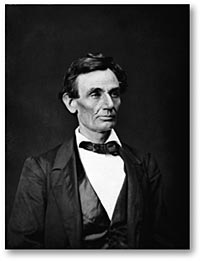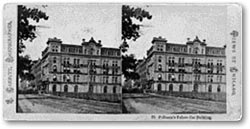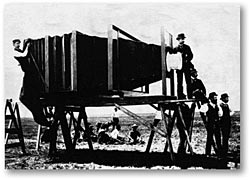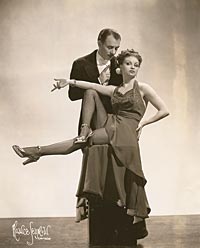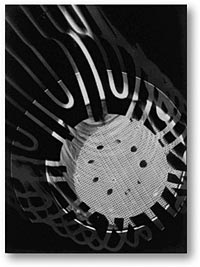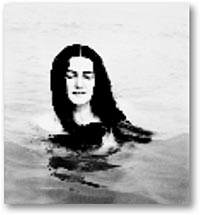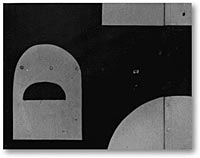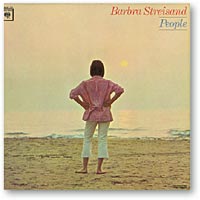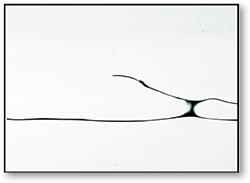|
Alexander Hesler
(1823-95)
Born in Montreal, Hesler learned the daguerreotype process in Buffalo in 1847. In 1855, he arrived in Chicago, and three years later, from atop the courthouse at the corner of Randolph and Clark streets, he captured a 360-degree panoramic photograph of the burgeoning city (you can see it at www.chicagohs.org/fire/prefire/hesler.html). Following the Republican convention of 1860, Hesler traveled to Springfield and shot perhaps the best-known photo of the beardless Abraham Lincoln. (“That looks better and expresses me better than any [photo] I have ever seen,” said Lincoln.) Following the great fire of 1871, Hesler moved his studio to Evanston, but he returned to Chicago around 1880. |
|
John Carbutt
(1832-1905)
After emigrating from England, Carbutt opened a studio in Chicago around 1860, and there he produced cartes-de-visite-small portraits that served as 19th-century calling cards. He also created nearly 200 stereographic views of Chicago, which, when seen through the proper apparatus, created a three-dimensional image of the pre-fire city. Carbutt experimented with several new forms of technology, including magnesium-flash photography and dry-plate processing. While still in Chicago, he traveled west to document construction of the Union Pacific Railroad. After an 1870 fire destroyed his studio, Carbutt decamped for Philadelphia, where he established the Keystone Dry Plate Works, created the first commercial X-ray plates, and introduced an early celluloid film. |
|
George R. Lawrence
(1869-1938)
“The hitherto impossible in photography is our specialty.” So ran the motto of George Lawrence, who came to Chicago from a Kankakee County farm in 1890 and opened a South Side photographic studio. He concocted new methods of synchronized flash photography and, in 1900, built the world’s largest camera: a 1,400-pound device with a 36-square-foot glass-plate negative. But Lawrence’s chief preoccupation was aerial photography. Originally he worked from a platform suspended from a balloon, but after two potentially fatal mishaps, he began using kites and other airborne contrivances to take pictures. His most famous aerial image is from May 1906, when he photographed San Francisco devastated by earthquake. |
|
Maurice Seymour
Billed in Hollywood’s golden age as “the photographer to the celebrities,” Maurice Seymour was actually two brothers: Maurice (1900-93) and Seymour (1902-95) Zeldman. Born in Russia, the pair came to Chicago in 1920, and nine years later opened their own studio-Maurice Seymour-atop the St. Clair Hotel. Bestowing a dramatically highlighted glamour on the city, they photographed film, theatre, and radio stars, judges and politicians, and the international luminaries of ballet, beginning, in 1934, with the Ballet Russe de Monte Carlo. When Seymour Zeldman moved to New York in the 1950s, both men legally changed their names to Maurice Seymour and continued to photograph into the 1970s. |
|
Laszlo Moholy-Nagy
(1895-1946)
In 1922, the Hungarian-born Moholy-Nagy moved to Berlin, where he experimented with pictograms, founded and led the photography department at the Bauhaus school, and opened his own design studio. Arriving in Chicago in 1937 at the invitation of Walter Paepcke, chairman of the Container Corporation of America, Moholy-Nagy opened the New Bauhaus School in the former Marshall Field mansion on Prairie Avenue; the school soon morphed into the School of Design and finally the Institute of Design (now part of the Illinois Institute of Technology). In all its incarnations, it featured a stellar collection of photographers-teachers who nurtured a new generation of would-be photographers. Only 51, Moholy-Nagy died from leukemia in Chicago in 1946. |
|
Harry Callahan
(1912-99)
“Photography is an adventure just as life is an adventure,” wrote Callahan in 1946-the year he moved from Detroit to Chicago to teach at the Institute of Design-and his seemingly commonplace photos are as much a complex exploration of Callahan’s psyche and surroundings as they are a careful analysis of light, line, and shadow. His everyday subjects included shorelines and trees, street scenes and grass plains, and, most memorably, his wife, Eleanor (above). In 1949, Callahan took over as director of the photography department at the institute, where he remained for 12 years, when he left for the Rhode Island School of Design. He and his wife retired to Atlanta in 1973, where he died at 86. |
|
Aaron Siskind
(1903-91)
Invited by Harry Callahan to join the faculty at the Institute of Design in 1951, Siskind was a former English teacher in the New York public schools who had changed courses to pursue a career in documentary photography. Later concluding that “the worship of the object per se . . . is not enough to satisfy the man of today” and that “the interior drama is the meaning of the exterior event,” he developed a new abstract language that influenced painters as much as it did photographers. Siskind followed Callahan to the Rhode Island School of Design in Providence, where he died of a stroke at 87. |
|
Don Bronstein
(1926-68)
In June 1963, in the midst of a three-week gig at Mister Kelly’s, the legendary Rush Street nightclub, Barbra Streisand traveled to the Lake Michigan shoreline with the photographer Don Bronstein. The first staff photographer for Playboy, where he shot covers and centerfolds before embarking on a freelance career in 1963, Bronstein shot Streisand in a radical pose-with her back to the camera. That photo graced the cover of Streisand’s classic fourth album, People, and both singer and cover won Grammys. |
|
Barbara Crane
(b. 1928)
Born in Chicago, Crane studied in California and New York, where she remained until 1952, working as a portrait photographer. Back in Chicago, she concentrated on her three children until 1960, when, with her youngest child in preschool, she returned to portrait photography. Eventually she enrolled at the Institute of Design and taught for 28 years at the School of the Art Institute, where she is a professor emeritus in photography. Ranging from what she has called “super reality” to more abstract compositions, her photographs appear in a variety of formats, from platinum and silver prints to Polaroid and digital images. |
Photography: Top Chicago History Museum, Middle Special Collections Dept./J. Willard Marriott Library/University Of Utah, Right © Bettmann/CORBIS © Maurice Seymour, © 2006 Artists Rights Society (Ars), New York/Vg Bild-Kunst, Bonn, © The Estate Of Harry M. Callahan, Courtesy Pace/Macgill Gallery, New York, Courtesy Of Stephen Daiter Gallery, Chicago History Museum © The Aaron Siskind Foundation/Siskind, Aaron 80:165:021 Chicago 20, 1957, Courtesy Of Stephen Daiter Gallery, © Bettmann/Corbis, © 1985 Newsweek, Inc. All Rights Reserved. Reprinted By Permission., Courtesy Of The Richard Nickel Committee, Skrebneski Photograph For The Chicago International Film Festival 1966



